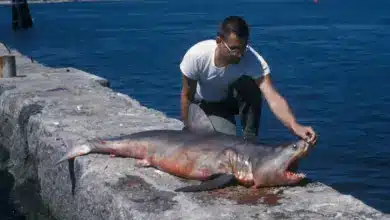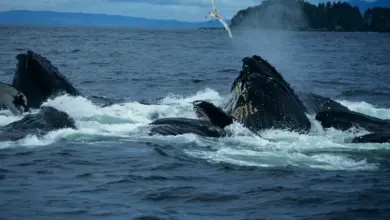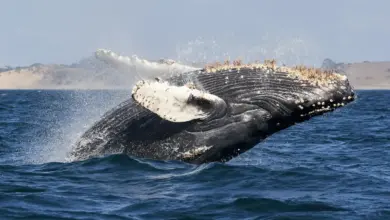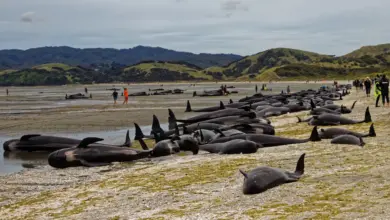The Disturbing Facts About ‘Dolphin-Safe’ Tuna
The Disturbing Facts About 'Dolphin-Safe' Tuna
A dolphin-loving American consumer would have to look hard these days to find a can of tuna that was not technically “dolphin safe.” Less than 2 per cent of all canned tuna sold in the US is caught by chasing and intentionally netting combined groups of yellowfin tuna and dolphins. The bad news is that the main “dolphin-safe” fishing method is responsible for killing a lot of other sea life—as well as at least a few dolphins.
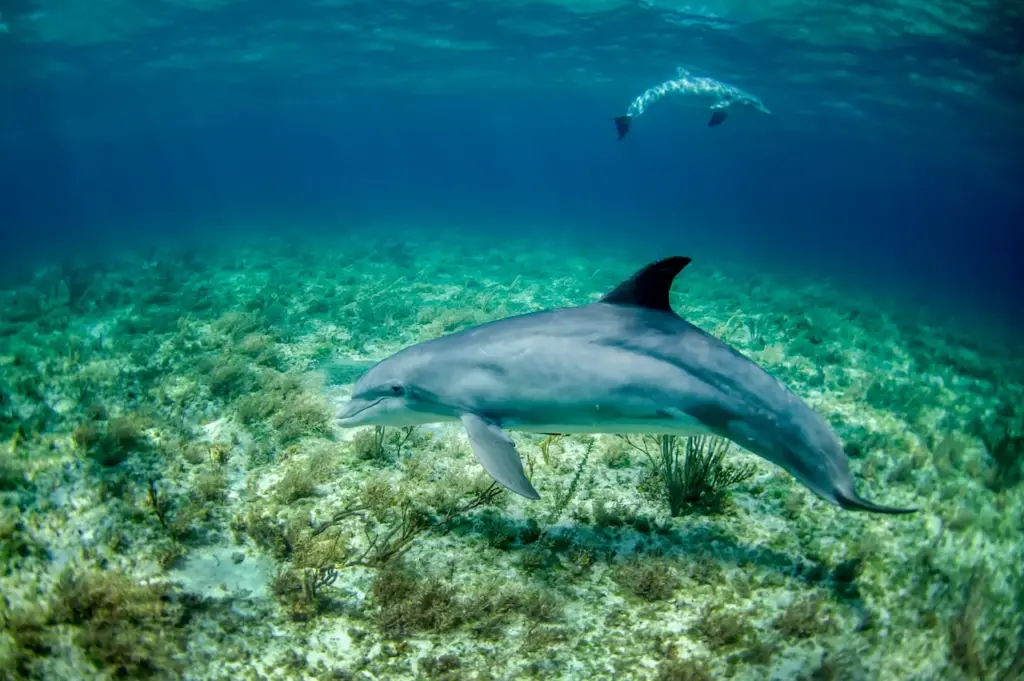
What Exactly Is Safe About it?
BY PAUL GUERNSEY
It has been a habit of mine for years: Whenever I buy a can of tuna in the supermarket, I conscientiously search the label for the “dolphin-safe” logo. Upon locating the emblemized image of the world’s most popular sea mammal and its accompanying handful of reassuring words, I invariably feel a little flash of relief followed by a brief glow of virtue. Then it’s on to the dressing aisle to get that jar of mayonnaise. . . .
Unfortunately, in the wake of some recent research into what the term “dolphin-safe” actually means, my enjoyment of a tuna sandwich—I like mine on rye, with lettuce and sliced Spanish olives—is now surrounded by a great deal more ambiguity than it used to be. This is not because I think the large, multi-national tuna fleet that operates off the western coasts of the Americas is still killing 130,000 dolphins every year the way it did before widespread public horror and a US consumer tuna boycott in the late 1980s led to sweeping changes in the fishery. By all accounts, it’s not—although some dolphins do continue to suffer unintentional drownings in purse-seine fishing nets.
Rather, most of my reservations now have to do with the “dolphin-safe” part of the tuna industry. And while fishermen using “dolphin-safe” methods off the coasts of western North and South America may be under-reporting the number of dolphins they kill—most “dolphin-safe” boats are too small to require observers aboard—it is not even primarily dolphins that I and many other conservationists are concerned about.
What bothers me—and should concern every environmentally conscious US consumer of canned tuna—is the tremendous number of fish, including sharks and other marine species, that are killed and discarded as “by-catch” by fishermen using the most widely employed “dolphin-safe” fishing technique—a collateral-damage problem that, ironically, the still-sizable contingent of non-dolphin-safe fishermen manages for the most part to avoid.
According to an estimate by the Environmental Justice Foundation, each dolphin spared by switching from “non-dolphin-safe” fishing techniques to the most widely employed alternative costs the lives of 25,824 small tuna (these are discarded, not kept and utilized), 27 sharks and rays, 382 mahi mahi (also known as “dolphin fish”), 188 wahoo, 82 yellowtail and other large fish, 1 billfish such as a marlin or sailfish and 1,193 triggerfish and other small fish.
Dr. Martin Hall, principal scientist for the Inter-American Tropical Tuna Commission (IATTC)—the regulatory body that oversees tuna fishing on the American side of the Pacific—offers estimates that, while still horrific, are somewhat lower, most notably, in the number of small tuna inadvertently killed per dolphin spared (15,620) as well as a smaller number of triggerfish and other small fish.
Of special concern to conservationists is the number of sharks caught as by-catch, because many species of these marine predators are under intense fishing pressure worldwide, and an increasing number of them have been appearing on the International Union for the Conservation of Nature (IUCN) Red List of Threatened Species.
US consumers have been purchasing tuna labeled as dolphin-safe since 1990.
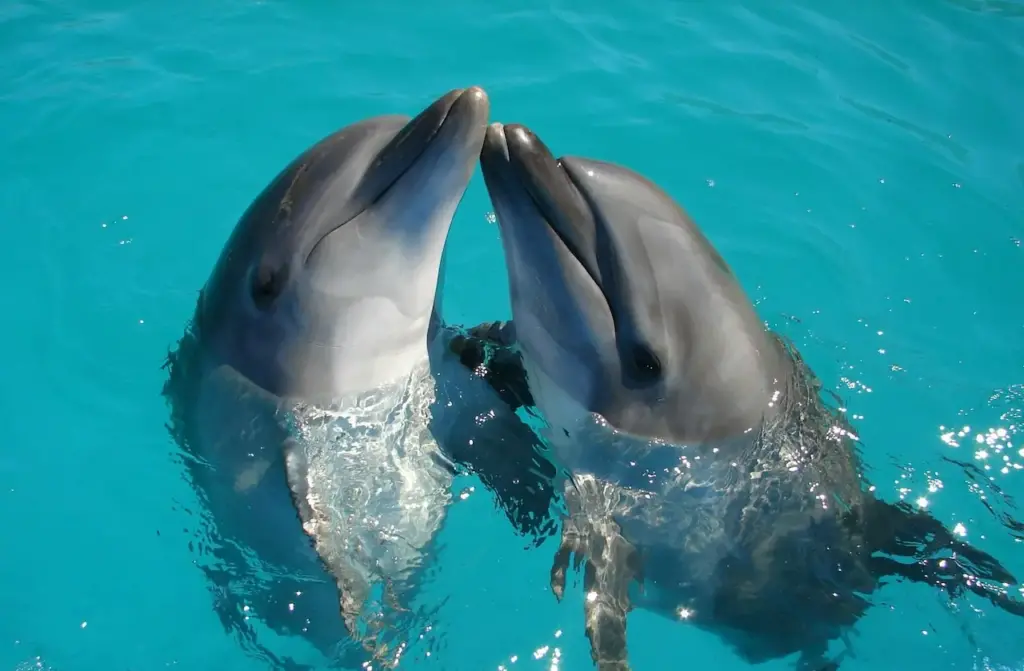
What Is—And Is Not—’Dolphin-Safe’ Fishing?
The most popular, and deadliest, “dolphin-safe” method involves netting tuna that have been attracted to a “floating object”—either a natural one such as a log, or a manmade Fish Aggregating Device (FAD). For reasons that are not completely understood, tuna like to school beneath debris they find floating in the ocean. It’s a fairly easy matter for the crew of a fishing boat to throw a purse-seine around such an object, and then gather in all the tuna that are swimming beneath it.
The problem is that fishermen haul in all the other marine life that has also been attracted to the floating object. This “by-catch,” comprised of undersize tuna, sharks and “non-target” fish species, often die and are discarded.
The use of FAD’s began to explode worldwide during the 1990’s after US consumers had begun to demand “dolphin-safe” tuna.
A much more environmentally friendly, though far less utilized, “dolphin-safe” tuna-fishing method involves finding and netting free-swimming schools of tuna. The tricky part is finding them: IATTC’s Dr. Martin Hall told All About Wildlife.com that, while electronic fish-finder devices can pinpoint fish swimming near or beneath a boat, technology to find schools of fish that are kilometers away has yet to be developed. As a result, much of the tuna captured this way are taken by fishermen who are lucky enough to happen upon them as they are preparing to employ one of the more productive—as well as more destructive—methods of harvesting the fish.
“Non-dolphin-safe” fishing techniques involve taking advantage of yet another poorly understood wildlife phenomenon: The tendency of dolphin herds and schools of yellowfin tuna to travel together in the Eastern Pacific Ocean off the west coasts of the Americas. Fishermen use the dolphins, which swim at the surface of the ocean in order to breathe, as animated “locator devices” for the tuna swimming below.
Although dolphins and yellowfin school together in a few other, scattered locations around the globe, the Eastern Pacific is the primary region where this odd behavior occurs. Scientists do not yet know why this is so. But because dolphins and tuna don’t swim together in all the waters they share, “dolphin-safe” techniques account for more than 90 percent of the world’s annual tuna harvest—not for the sake of dolphins, but because “dolphin fishing” does not work in most places.
According to numbers provided by both the Food and Agricultural Organization of the United Nations and the IATTC, in 2007 (the last year for which figures are available) around 17 percent of the world’s yellowfin tuna—and around 12 percent of the global combined harvest of yellowfin, skipjack and bigeye tuna—were caught in the Eastern Pacific. During that same year, nearly 60 percent of yellowfin tuna taken in the Eastern Pacific were caught “on dolphins,” with the remainder captured using dolphin-safe methods. Almost all non-dolphin-safe tuna goes to countries that don’t use the US dolphin-safe labeling system; as a result, most of the tuna consumed by Americans comes from the naturally “dolphin-safe” Western Pacific and other regions.
Increasingly, throughout the world’s oceans, dolphin-safe fishermen are using FAD’s rather than targeting hard-to-locate free-swimming schools of tuna. And with each FAD added to the fishery, the amount of by-catch goes up. More sharks, billfish, juvenile tunas, occasional sea-turtles and, yes, sometimes even dolphins are netted, drowned and discarded.
Of additional concern to conservationists is the fact that most dolphin, fish and turtle by-catch mortality caused by floating-object fishing is self-reported by the fishermen, since unlike most of the large boats that dolphin-fish in the Eastern Pacific, boats that set their nets on objects are usually too small for fisheries regulators to require them to carry an observer aboard.
In the words of a 2001 report by Consumers Union of the US (publisher of Consumer Reports), “Some tuna-fishing methods can injure or kill dolphins. The ‘dolphin safe’ logo indicates that those methods weren’t used or that dolphins weren’t harmed in the process. However, because independent verification of such claims—by observers who board fishing boats or make surprise visits to canneries to inspect captain’s logs—is not universal, the logo is not an ironclad guarantee that the tuna in any given can was caught according to the standard.”
When I asked Sarah Wilkin, a fishery biologist with the US National Marine Fisheries Service, how we could be certain we were getting accurate by-catch information from the smaller, observerless fishing boats in the Eastern Pacific fleet, she said, “I don’t think we have a good way of knowing that.”
Here’s How ‘Dolphin Fishing’ Works
In the words of Dr. Martin Hall, in his 1998 analysis, An Ecological View of the Tuna-Dolphin Problem: Impacts and Tradeoffs :
“When the fishers detect a group of dolphins, of one or more of the species known to be associated with tunas (from the Fam. Delphinidae: spotted dolphin, Stenella attenuata, spinner dolphin, S. longirostris, common dolphin, Delphinus delphis, or, less frequently, striped dolphin, S. coeruleoalba), they attempt to confirm the presence of tuna either with the aid of the helicopter, or from the vessel.
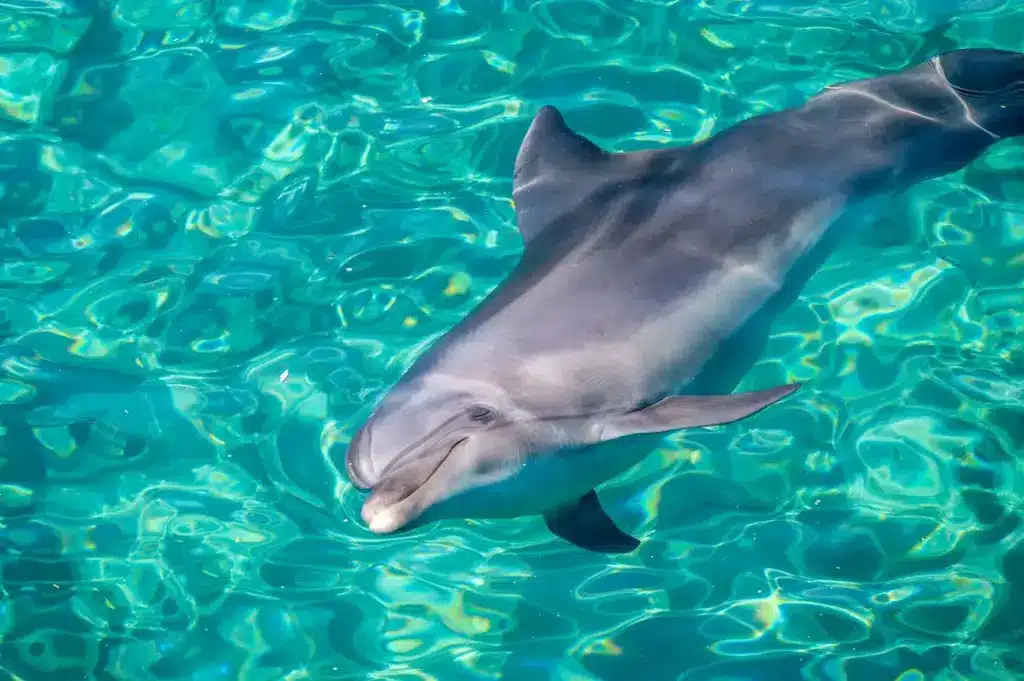
“When fish are present, they launch four or five speedboats that chase the dolphin herd, making a wide arc typically at a distance of (between 100 and 200 meters) to the side and behind the herd. The chase usually lasts about 20 to 30 minutes, and when it finishes, the dolphin herd has slowed down, or stopped. During this process, part or the whole dolphin herd may evade the chase and/or encirclement, or, if it is not carrying tuna, may be deliberately excluded from the encirclement area through the actions of the speedboats.
“At this point, the seiner begins to surround them with the net, while the speedboats maneuver in such a way as to keep them inside the encircled area. Then, the net is “pursed,” and both the dolphins and the tunas that were associated with them are captured. The technique is called dolphin fishing, and the sets are called dolphin sets. At this point, the fishers wish to release the dolphins and then bring the tunas aboard the vessel. The average size of the dolphin group captured is about 400 to 500 dolphins, but it is common to see groups of more than 1,000 dolphins in the net.”
During the 1960’s, ’70’s and ’80’s, “dolphin fishing” resulted in the drowning deaths of as many as 8 million dolphins. Then came publicity in the form of some shocking videotape of drowned dolphins being removed from fishing nets and discarded. The ensuing public outrage and a US consumer boycott led by the Earth Island Institute and other conservation organizations had three main results:
1) A growing number of fishermen in the Eastern Pacific began using “dolphin-safe” methods as a way of appeasing US tuna-eaters. And increasingly, rather than searching the ocean for natural floating objects to put their nets around, they began launching their own floating objects—FAD’s.
2) Fishermen who used dolphins to catch tuna, rather than fading away, began to develop techniques for releasing dolphins alive from their purse seines. They continued selling their tuna just as they had before—but they sold it in non-US markets.
3) FAD fishing, because it is so efficient, spread like wildfire through the world’s tuna fisheries.
The main technique for releasing captured dolphins is called “backing down” by the fishermen and their regulators. It involves a 15- 30-minute pause in the fishing operation once the schools of dolphins and tuna have been taken into the net. During that pause, the fishing boat stops drawing in the purse seine and slowly “backs down” on it, causing part of the net to sink, thereby creating a “backdown channel” through which the dolphins can escape. Further precautions include covering the top portion of the purse seine with a skirt of mesh that prevents dolphins from catching their beaks or heads in the net, as well as fielding a team of divers that herds the dolphins through the backdown channel and aids any that are entangled or otherwise in trouble.
These measures have been highly effective by almost all accounts. According to IATTC, in 2008, fewer than 1,200 dolphins were killed in purse seines in the entire Eastern Pacific—a number that is generally regarded as reliable because of the fact that almost all fishing vessels that use dolphins to catch tuna are large enough—over 363 tons—to be required to carry an IATTC observer aboard.
The National Marine Fisheries Service’s Sarah Wilkin adds, “You also have to give a little bit of the credit to the dolphins for learning how to behave. (During the backdown process) they know it’s time to go, and they are basically orderly.”
However, one organization that casts doubts on the reduced mortality figures is the Earth Island Institute, which from the beginning has been a major promoter of dolphin-safe fishing, going so far as to permit the use of its own “dolphin-safe” logo on some brands of tuna.
According to Mark Berman of Earth Island institute’s International Marine Mammal Project, IATTC is heavily influenced by the Mexican tuna industry, and therefore may not be fully trustworthy in its reporting of dolphin fatalities.
In addition, Berman told All About Wildlife.com, “Observers are sometimes known to be under pressure to look the other way when dolphin mortality may be occurring. They can be forced or bribed to go below decks,” when nets are being drawn in, Berman said.
Berman added that his organization believes there is a higher “cryptic kill” of dolphins—deaths that occur after their release—than IATTC’s observers have been reporting. He attributes this cryptic mortality to injuries or stress suffered during the fishing process, as well to the deaths of dolphin calves that have been separated from their mothers.
“If (observers) don’t see dolphins floating in the nets, they don’t count them as killed,” Berman said.
But IATTC’s Dr. Martin Hall countered that dolphin populations have been rebounding ever since fishermen learned to release them alive. “To me, abundance is the ultimate test, and the numbers are going up,” he said.
Hall added that there is little evidence calves stay separated from their mothers for significant lengths of time. He said adult dolphins were accustomed to waiting for the slower calves to catch up with them in open water, and that the herd does not abandon calves once it had been freed from the fishing nets.
“These guys are used to finding each other,” he asserted.
In spite of their differences, both men agree that by-catch of species other than dolphins is much greater in floating-object fishing than it is when tuna are caught “on dolphins.” But they differ greatly on the implications of this fact.
While Hall believes the US and the world at large should perhaps give the 21st century version of “dolphin fishing” some further consideration, Berman and his group are vehemently opposed, as are virtually all other conservation organizations.
“There can be no encirclement or chasing of dolphins, period,” Berman said. “You do not chase and harass dolphins to the point of exhaustion.”
Berman said that while he believes further research needs to be done to reduce floating-object by-catch, he admits that non-mammalian species are not his organization’s primary concern. “Dolphins are our main deal. The Project was founded to stop tuna from being caught on dolphins.”
Other conservation organizations, however, while not in favor of a return to dolphin fishing, are taking a more active approach toward the relative destruciveness of floating-object fishing.
For instance, John Hocevar, director of Greenpeace’s Ocean Campaign, told All About Wildlife.com that, “Greenpeace is calling for a ban on fishing with FAD’s, which have serious by-catch problems. Of particular concern is the by-catch of juvenile bigeye tuna, but many other species—including turtles and sharks—are taken as well.”
Hocevar adds, however, that “Setting nets around dolphins is clearly unacceptable.”
So, What’s a Tuna Lover To Do?
I began researching this article with the apprehension that I might discover dolphin-safe tuna labels were a sham, and that dolphins might still be dying by the tens of thousands in tuna-fishing nets. That apprehension has been largely laid to rest.
In its place, however, have risen several new worries about all the various tuna-fishing methods and what they are doing to our ocean environments. Along with the serious by-catch problem associated with floating-object fishing, there are several other fish-harvesting techniques that kill non-target species.
For example, longline fishing—in which thousands of yards of baited hooks are strung across the ocean—is especially hard on non-target species including seabirds; in fact longlines kill far more endangered sea turtles than do purse seines.
And, according to Greenpeace’s John Hocevar, the real problem with tuna fishing has nothing to do with any particular fishing method. Rather, it’s the fact that tunas overall are being seriously overfished.
Hocevar told us, “Today, the greater problem is overfishing of tuna. Bluefin populations have plummeted to the point where an
international ban on trade is necessary to save these spectacular fish. Bigeye are overfished as well, but instead of rebuilding their populations, policy makers are allowing overfishing to continue. Several stocks of yellowfin and albacore tuna are overfished as well. In every ocean, policy makers are failing to adhere to the advice of their own scientists. Short-term economic interests continue to win out over science and sustainability, and both tuna and fishing jobs are rapidly disappearing.”
Some fisheries researchers have been responding to the problems by trying to come up with ways to reduce by-catch mortality. For instance, according to IATTC’s Dr. Hall, FAD fishermen could develop techniques for quickly sorting out and setting free sharks they have caught before the animals drown in their nets.
But, without observers aboard those boats, how would anybody know how well those techniques actually were working, and whether the fishermen were really employing them?
Another proposal has been to bring back the pole-and-line fishery that was the predominant method of catching tuna before the industry became mechanized during the 1950’s. However, one problem with pole-and-line fishing—aside from the fact that it is not very efficient—is the fact that it requires the use of large amounts of baitfish, and those baitfish would have to be regarded as another form of by-catch.
So, should we just stop eating tuna?
Hall had some interesting thoughts on the idea of another widespread boycott by US consumers. He told us, “If you are a society that is interested in conservation, you have two choices. You can reject the product, or you can accept the product with conditions.
“If you reject the product—if you shut down the market—you have lost your leverage. You have lost the ability to influence the fishery, because the fishermen are just going to sell their product somewhere else. So, what have you gained?”
It may be far better, suggested Dr. Hall, to keep buying the product—while at the same time constantly and publicly pressuring the fishing industry to clean up its act.
In the end, every consumer must make his or her own choice. For my part, I’m not ready to give up on eating tuna. But what I do plan to do is to pay more attention to what conservation organizations are saying about the issues concerning tuna and other ocean fisheries. Following are links to some of the ones I’ll be listening to
